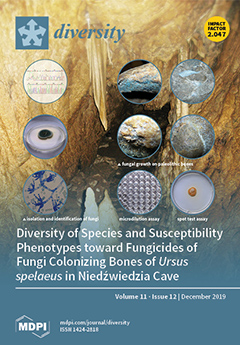This study aims to determine the effects of crops and their cultivation regimes on changes in the soil microbiome. Three plant species were selected for the study:
Triticum aestivum, Brassica napus, and
Pisum sativum ssp.
arvense, that were cultivated in soils
[...] Read more.
This study aims to determine the effects of crops and their cultivation regimes on changes in the soil microbiome. Three plant species were selected for the study:
Triticum aestivum, Brassica napus, and
Pisum sativum ssp.
arvense, that were cultivated in soils with a similar particle size fraction. Field experiments were performed on the area of the Iławski Lake District (north-eastern Poland) at the Production and Experimental Station ‘Bałcyny’ (53°35′49″ N, 19°51′20″ E). In soil samples counts, organotrophic bacteria and actinobacteria were quantified, and the colony development index (CD) and ecophysiological diversity index (EP) were computed. In addition, a 16S amplicon sequencing encoding gene was conducted based on the hypervariable region V3–V4. Further analyses included an evaluation of the basic physiochemical properties of the soil and the activities of dehydrogenases, catalase, urease, acid phosphatase, alkaline phosphatase, arylsulfatase, and β-glucosidase. Analyses carried out in the study demonstrated that the rhizosphere of
Triticum aestivum had a more beneficial effect on bacteria development than those of
Brassica napus and
Pisum sativum ssp.
arvense, as indicated by the values of the ecophysiological diversity index (EP) and OTU abundance calculated for individual taxa in the soils in which the studied crops were grown. More OTUs of the taxa
Alphaproteobacteria, Gammaproteobacteria, Clostridia, Sphingomonadales, Rhodospirillales,
Xanthomonadales,
Streptomycetaceae, Pseudonocardiaceae, Acetobacteraceae,
Solibacteraceae, Kaistobacter, Cohnella, Azospirillum, Cryptosporangium, Rhodoplanes, and
Saccharopolyspora were determined in the bacteriome structure of the soil from
Triticum aestivum cultivation than in the soils from the cultivation of
Brassica napus and
Pisum sativum ssp.
arvense. Also, the activities of most of the analyzed enzymes, including urease, catalase, alkaline phosphatase, β-glucosidase, and arylsulfatase, were the higher in the soil sown with
Triticum aestivum than in those with the other two plant species.
Full article





